Backpacking Sweet Potato & Peanut Stew
This post may contain affiliate links.
This dehydrated sweet potato peanut stew is the backpacking version of one of our most popular car camping recipes. Loaded with a hearty mix of sweet potato, chickpeas, and kale, this backpacking meal will have you wanting seconds.
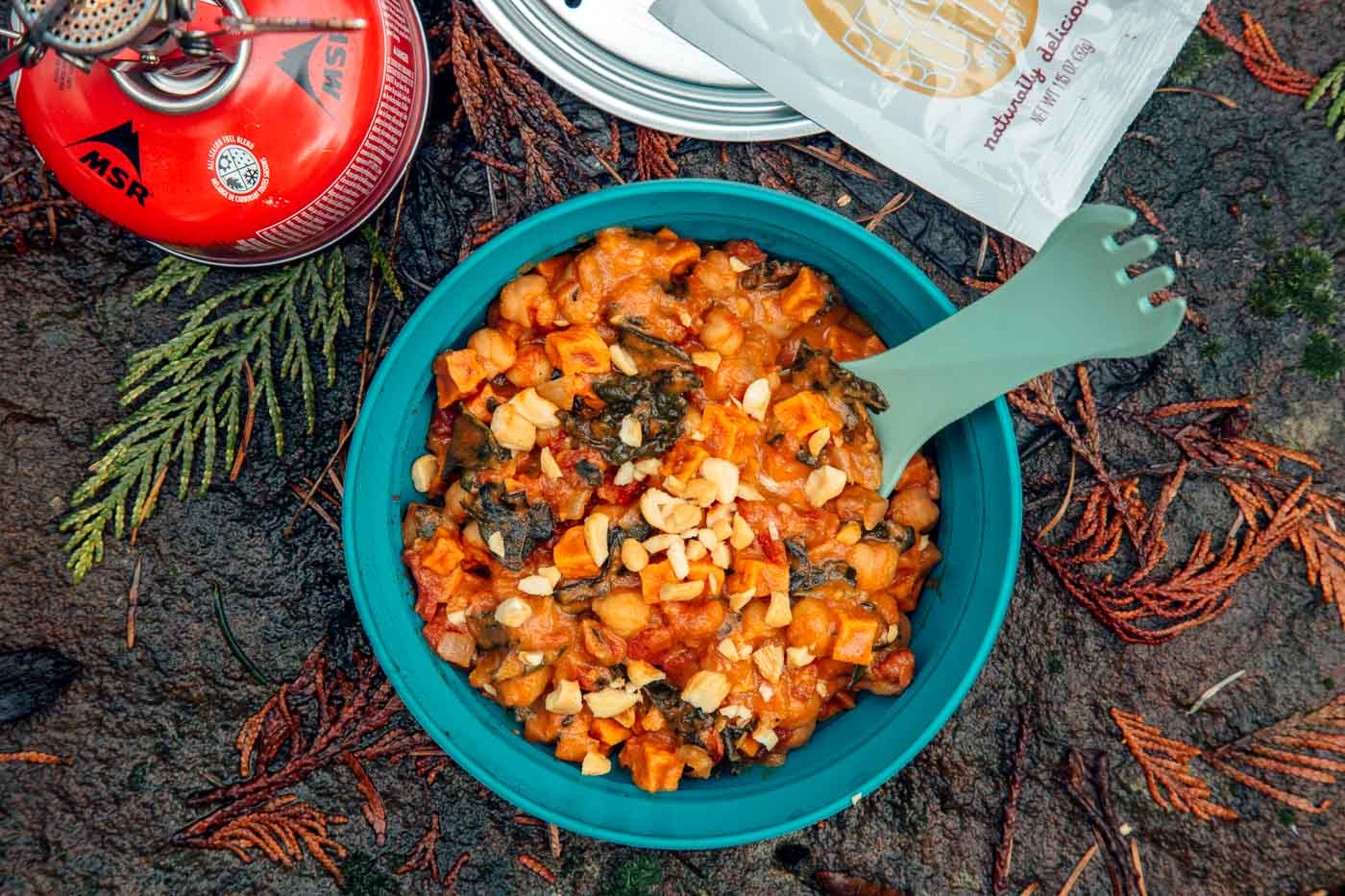
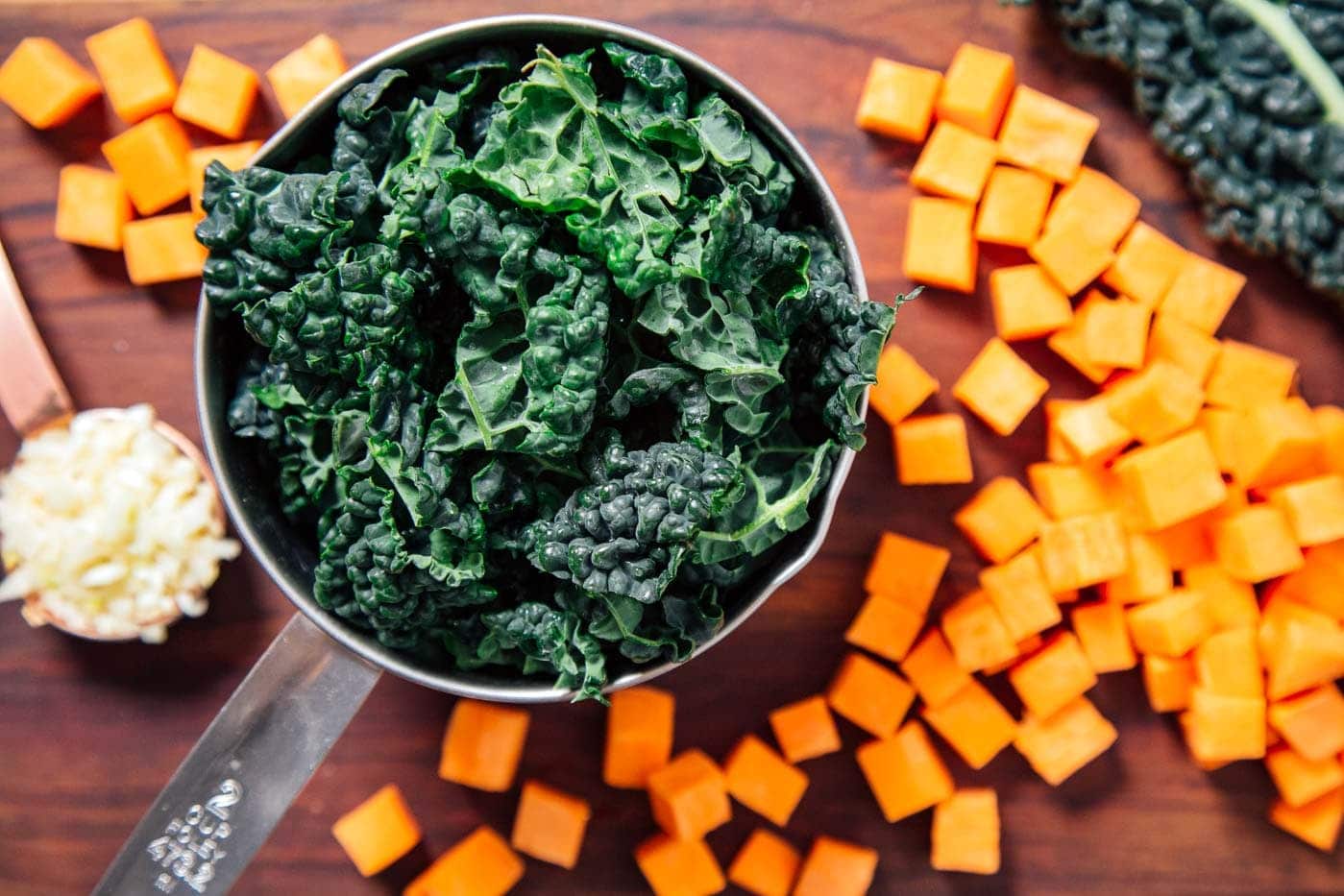
Ingredients
Sweet Potato: While you could theoretically use any type of potato for this recipe, we think the sweetness of a sweet potato really balances out the other flavors.
Chickpeas: This is where the bulk of the meal’s protein comes from.
Kale: We prefer flat-leafed kale, also known as Tuscan or Dinosaur, because it retains its texture even after it’s cooked, dehydrated, and simmered again on the trail.
Diced Tomatoes: You can use either regular diced or fire-roasted tomatoes. Be aware of any additional seasonings that might be listed on the label.
Peanuts: Chopped peanuts really add a nice crunch to the meal. Having diverse textures in a meal can be a real luxury out on the trail.
New Mexican Chili Powder: Milder and smokier than most chili powders. You could also blend smoked paprika and regular chili powder together to achieve a similar effect.
Ground Ginger: This adds a slightly exotic warming spiciness to the dish.
Peanuts Butter Packet: Justin’s, Wild Friends, and even Target sell individual packets of peanut butter. This is important for adding in on-site.
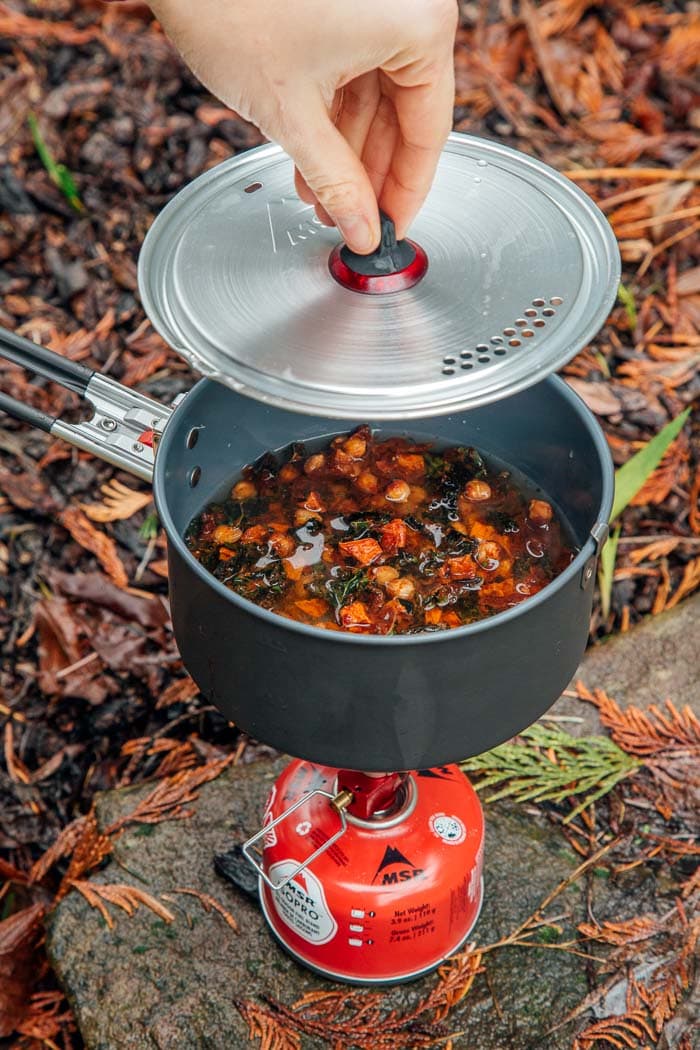
Essential equipment
↠ Dehydrator: For this recipe, we used a Nesco Snackmaster Pro. While it lacks some of the fancy controls of more expensive models, we have found it to be a great, budget-friendly starter dehydrator.
↠ Dehydrator Sheets: If your dehydrator doesn’t come with solid fruit leather trays, then you will need to pick them up. The stew will be – well – rather stewy, so you’ll need a solid tray in order to properly dehydrate it.
↠ Backpacking Pot: When we’re cooking our own meals out on the trail, we use this MSR ceramic coated pot. The aluminum body distributes the heat well while the non-toxic non-stick surface prevents us from scorching our food.
↠ Backpacking Stove: We use an MSR Pocket Rocket 2 with our pot.
↠ GoToob: These sealable (and lockable) liquid containers are our go-to for storing oils and sauces when backpacking.
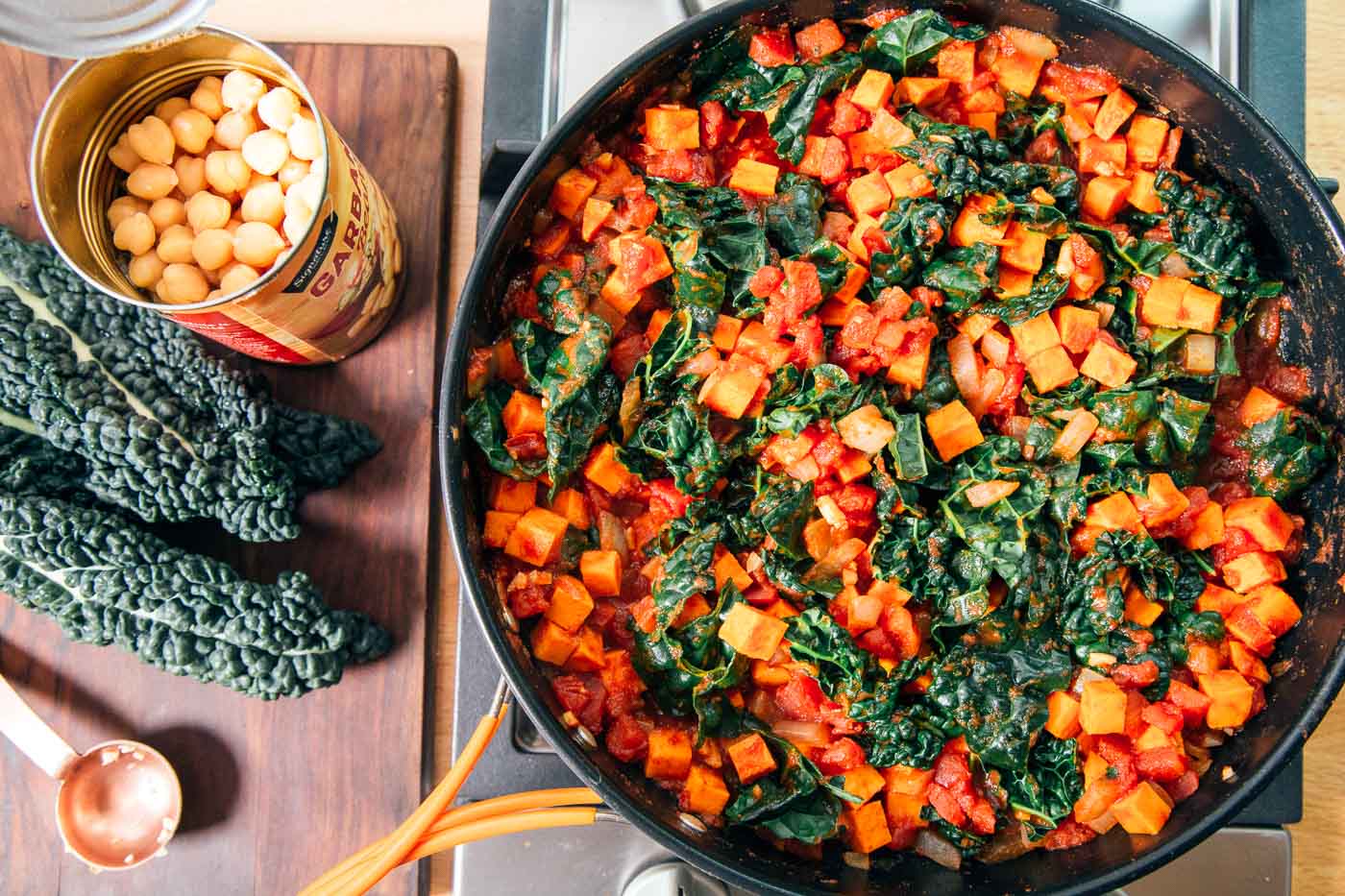
How to make sweet potato peanut stew for backpacking
The main way this recipe differs from the original is the elimination of oils during the initial cooking process. By using no oil upfront, the meal can be properly dehydrated and safely stored. Then out on the trail, you can add the oils back in to give it flavor and bump up the calories.
This recipe starts by sweating a chopped onion over medium heat. Unlike sauteing or carmelizing, the goal here is to soften the onion without browning it and to release some of its aromatic flavors. This could be done with oil, but we’re doing it by adding a small amount of water (just enough to keep the onions from sticking). As the water evaporates, we add a little more.
Once the onions are soft and translucent, you can go ahead and add the garlic. Continue for about 30 seconds or until garlic becomes fragrant.
Then it’s time to add the rest of your stew ingredients: cubed sweet potatoes, rinsed chickpeas, diced tomatoes with juices, chopped kale, and vegetable broth. You can also mix in your seasoning at this time: ground ginger, New Mexico chili powder, and salt. Mix together, bring to a boil, and then reduce to a simmer until sweet potatoes are tender (roughly 10 minutes).
At this point, the stew will be wet but won’t have as much liquid as we ultimately want in the final product. That’s fine. All the liquid has got to come out in the dehydrating process anyways, so there is no point in starting with a really soupy stew. Besides, we’ll add the liquid back in at camp.
However, this is a great time to taste for seasoning. Is there enough salt for you? Want more chili powder? This is the time to dial in the flavor to your personal preference – but remember that the final version will have additional flavor from the peanuts and peanut butter!
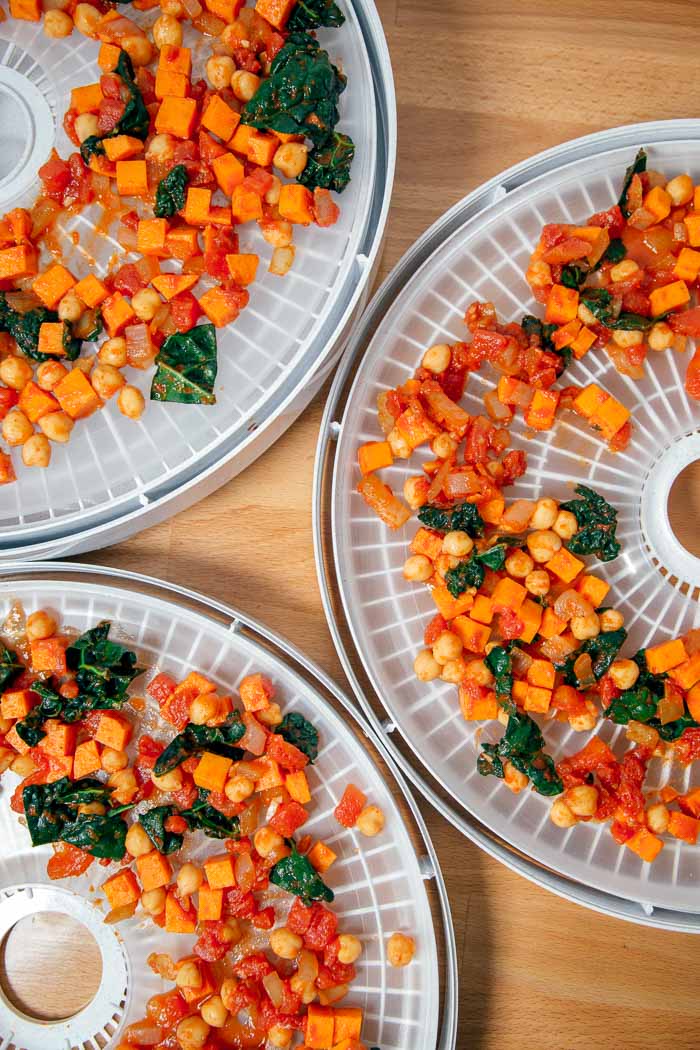
Once the stew is ready, it’s time to start dehydrating. We used the solid fruit leather trays that came with our dehydrator, which are perfect for dehydrating wet ingredients like this. Before we add anything to the trays, we like to rub a very light layer of oil on the trays with a paper towel to make it easier to remove the ingredients once fully dehydrated. We’re talking about a drop or two per tray, so it’s a very minimal amount of oil. But you can omit this step if you’re really concerned about the longevity of your dehydrated meal.
It’s not really possible to over dehydrate these ingredients, so we let the dehydrator run overnight for about 8-12 hours. Once all the ingredients are completely dry, we remove them from the trays and portion them in sealable containers along with the chopped peanuts.
When packing this meal for a backpacking trip, there are two other add-in ingredients you will want to bring along: peanut butter packets and some oil. We love having an assortment of Justin’s Nut Butters along with us on backpacking trips, so we just reserve two for this meal. (We recommend plain peanut butter for this recipe, not the flavored varieties).
You will also want some oil. We add oil into nearly all of our backpacking recipes as a way to boost the calorie count, so we travel with a GoToob of oil. You’ll only need a tablespoon or two.
At camp, we empty the dehydrated ingredients into our cook pot and add just enough water to cover. We then bring it up to a boil and simmer 15-20 minutes (covering with a lid to conserve fuel). Once the chickpeas are tender, it’s basically ready. If we want the stew to be a little soupier, we add in some more water. Then we stir in the peanut butter and oil, mixing thoroughly to combine. The final product is rich, creamy, smoky, spicy, and nutty.
If you’re looking for a really hearty vegan backpacking meal to trip out this season, give this dehydrated Sweet Potato Peanut Stew recipe a try!

Tips & tricks
↠ Sweating the onions and garlic in water will help draw out their flavor without adding oil to the ingredients, which has the risk of going rancid over an extended period of time.
↠ Check the flavor (seasoning and salt levels) of the stew before putting it in the dehydrator. This is your opportunity to dial it the flavor to exactly what you want when you’re out on the trail.
↠ Use a solid fruit leather tray in your dehydrator to keep the wet ingredients together.
↠ Don’t omit the roasted chopped peanuts, which really diversify the texture profile!
↠ Justin’s, Wild Friends, and even Target sell great individual peanut butter packets that can be added at camp.
↠ A little bit of oil can go a long way. Use a GoToob to transport some olive oil in the backcountry to help bulk out the calorie count of your meals without adding a ton of weight.
Other DIY backpacking meals you’ll enjoy
↠ Red Lentil Chili
↠ Dehydrated Risotto
↠ Thai Red Curry Rice
↠ Spicy Backpacking Jambalaya
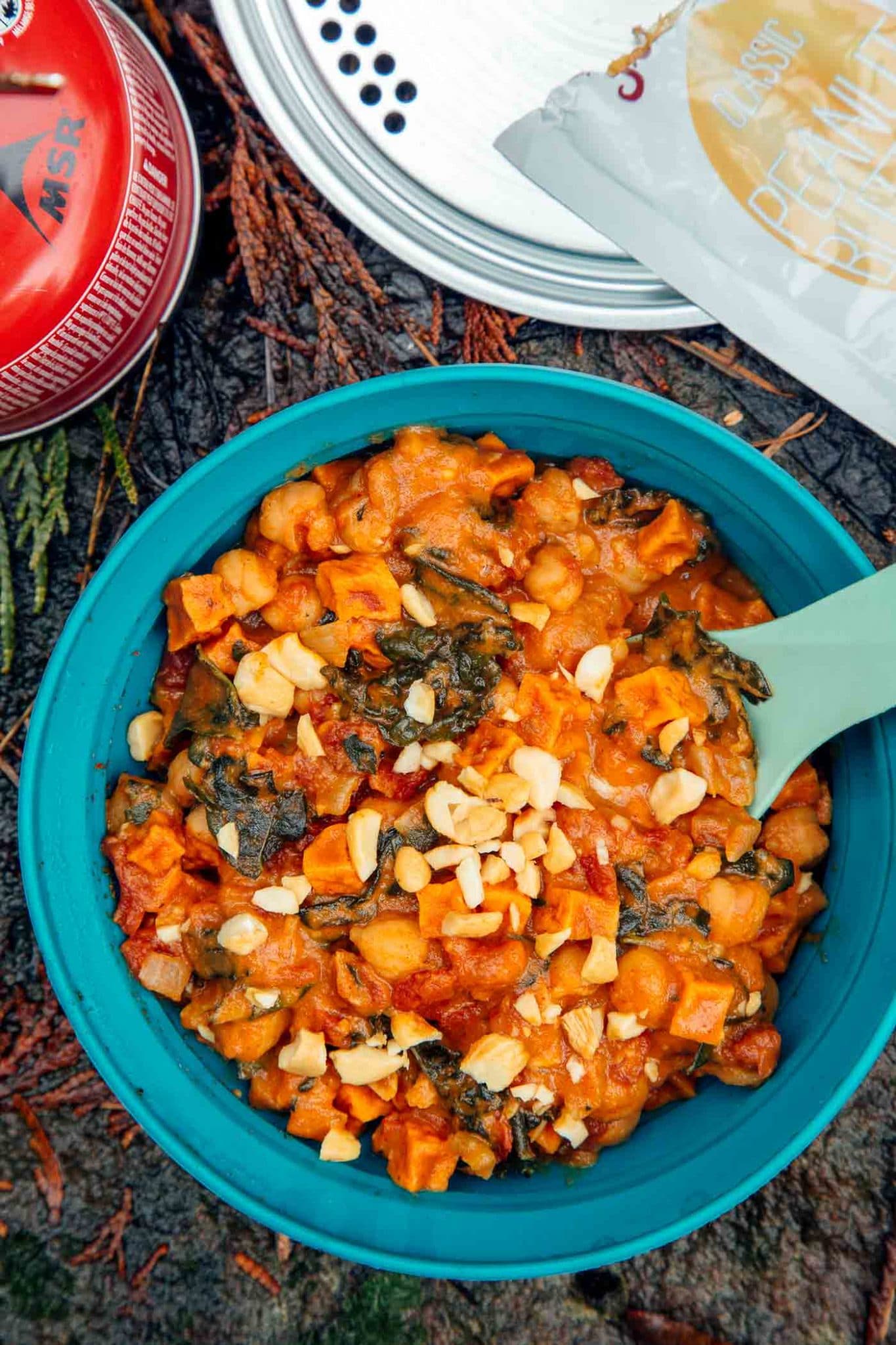

Dehydrated Sweet Potato Peanut Stew
Ingredients
Equipment
Instructions
At Home:
- Heat a high-sided skillet or pot over medium. Add the onions and a bit of water. Sweat until the onion is translucent, adding more water as it evaporates out. Add the garlic, sweet potato, tomatoes & their juices, kale, chili powder, ground ginger, salt, and broth. Simmer until the sweet potatoes are tender, about 10 minutes. Stir in the chickpeas.
- Spread the stew in an even layer on dehydrator trays that have been lined with a fruit leather insert or parchment paper. Dehydrate at 135F for 8-12 hours or until the chickpeas and sweet potatoes are completely dry. Package in airtight containers or zip-top bags along with the crushed peanuts.
- Before departing on your trip, additionally pack the peanut butter packets and oil in a small container.
At Camp:
- Place the stew in your cookpot with enough water to cover. Simmer 15-20 minutes or until the chickpeas are tender, adding more water as needed. You’ll want a bit of liquid left at the end, but not enough to make it too soupy.
- Mix the peanut butter and olive oil into the stew until thoroughly combined. Enjoy!


We made this for our backpacking trip in Red River Gorge, KY. It was the end of February, so it was pretty darn cold outside! After a long day hiking, this stew was THE BEST! It was warm, delicious and filled us up for a great night’s sleep. Definitely recommend this to anyone looking for a great, hearty backpacking meal!
So glad you enjoyed it! A warm meal at the end of the day of backpacking really does hits the spot!
I purchased all the ingredients to make this for a backpacking trip next week. Since you’re cooking all the vegetables/ingredients in a skillet before dehydrating do you still need to steam or blanch the vegetables (as your “how to dehydrate” guide recommends)? I’m assuming not but just want to be sure! Thanks.
Correct. Sweating the onions (with water) and then simmering everything else in the skillet until tender will have the same effect as blanching. Have an awesome trip! Let us know how the meal turns out!
Took this on my recent trip to the Sierras! Very tasty!
I’ve been dehydrating meals for bushwalking for a couple of years, and I have just done a trial run of this recipe to add to my meals for an upcoming 20 day hike…. I LOVE it! The peanut butter at the end really makes this dish. Definitely one of my top 3 meals haha. I didn’t add kale, but I will have dehydrated spinach which I will add whilst on the trail. Thanks! 😀
Made this and found we had to simmer for way longer than 20 min to get the beans soft. Will try again but will pre soak to shorten the summer time. Flavor was great though.
I’m sorry to hear that! Beans can be difficult to rehydrate out in the field sometimes. One option could be to slightly mash your beans at home before dehydrating. More like slightly squished, not really mashed, so they retain their shape. This will allow them to dehydrate and rehydrate faster.
Do you ever cut the chick peas in half? I am wondering if this will hasten the dehydration/rehydration process.
This recipe sounds great. Thanks.
We have not tried cutting the chickpeas in half, although I’m sure that will decrease dehydrating time at home and increase their ability to rehydrate out in the field. So definitely a good idea – if a little time consuming on the front end (cutting each individual chickpea). Another idea could be to ever so slightly mash the chickpeas, so they squish a little but still retain most of their shape. This will accomplish the same goal of accelerating the dehydrating and rehydrating process.
So much peanutty deliciousness….YUM!!!